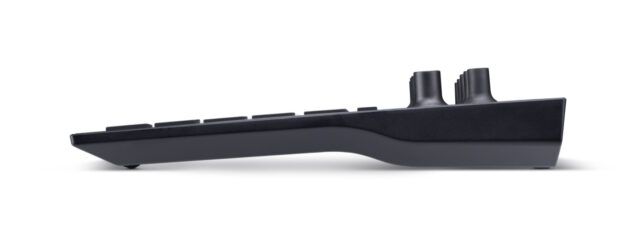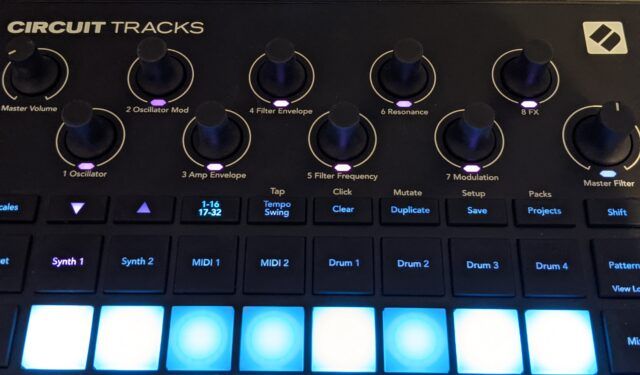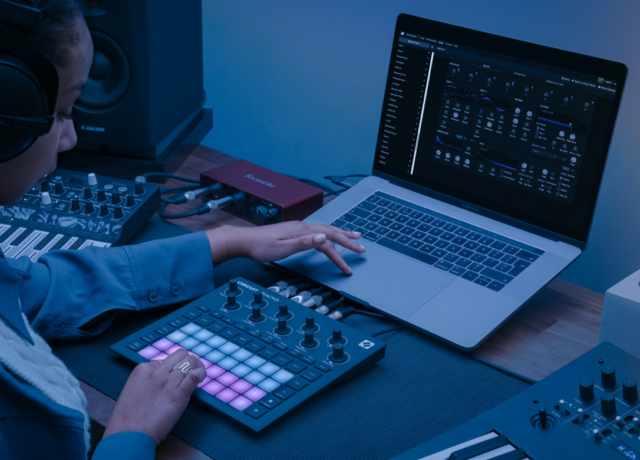Novation has just released the Circuit Tracks, an improved version of its beloved Circuit groovebox. The original Novation Circuit is largely responsible for the resurgence of hardware music production gear, and has a soft spot in many producers’ hearts due to its highly intuitive workflow. The Tracks builds on the impressive legacy of the original Circuit by providing a variety of new features: a built-in battery, two mono inputs, improved build quality, extra MIDI sequencing tracks, and an updated layout.
This review aims to compare the Tracks to the original Circuit, as well as provide a complete overview of the Tracks for potential new buyers.
Overview
The Novation Circuit Tracks is marketed as a groovebox – a term coined by Roland in the 1990s to describe a self-contained electronic music production interface. The Circuit Tracks fits this description well, with two internal synth engines, an intuitive pad-based sequencer, and four monophonic drum samplers. The device focuses on providing a simple and intuitive workflow – select a scale, choose a preset, dial in a synth sound with the eight macro knobs, sequence or record a pattern, lay down a drum beat, and add in delay and reverb. This process, which typically takes anywhere from 10 minutes to almost an hour in a DAW, is doable in seconds on the Circuit.
Hardware and Build Quality

The Circuit Tracks is a massive improvement over the original Circuit in terms of build quality. It is built with an extremely light plastic chassis, but is still very sturdy and has no problems with bending or wobbling. The 32 velocity-sensitive pads feel great, and are derived from Novation’s famous Launchpad range. The pads’ velocity response is spot-on, and they have just the right amount of squish and give for finger-drumming and playing. The rubber encoders each have their own corresponding LED that changes in brightness to display parameter values. The pads, encoder LEDs, and buttons are all color-coded for simplicity: Synth 1 uses purple, Synth 2 uses green, MIDI 1 is teal, MIDI 2 is orange, and so on. I was pleased to find metal shafts underneath each pot, which sit tightly beneath their rubber caps. The case is finished in black matte, which feels very premium but does tend to scuff easily. Because of this, I would recommend investing in a case or separate bag when traveling with the Tracks.

The Circuit Tracks offers a huge improvement over its predecessor in terms of I/O selection – two ¼ jack balanced mono inputs, stereo ¼ balanced master and minijack headphone outputs, a 5-pin MIDI DIN trio, analog sync out, and a USB-C connector for charging, interfacing, and USB MIDI purposes. This wealth of connectivity options allows the Circuit to control and interface with almost any type of gear, thus letting the Circuit act as a DAWless brain and master sequencer for a whole setup.
Workflow
The Circuit Tracks is quite similar to the original Circuit, whose workflow is highly renowned for being simple and fun. I certainly found that to be the case during my time with the unit, and was able to come up with ideas quickly as well as perform with the device in a DJ set.
The pads
The 32 pads are used for sequencing, performing, and menu selections, with their default mode providing a 16-note scaled keyboard and a 16-step sequencer for the selected track. Several menu settings such as scale, pattern options, and gate are accessed by holding a corresponding button down and using the pads to change settings, which is surprisingly intuitive. The pads’ RGB control is taken full advantage of by Novation, with different colors corresponding with different tracks, menus, and settings. Pattern-chaining, parameter locking, automation, and the like are all simple to do. That said, I didn’t love the 32-step pattern length, and I’d hope to see it expanded to 64 steps in a future firmware update.
The sequencer
The sequencer was one of the main aspects of the original Circuit to receive massive firmware updates, bringing many features such as micro-step or probability that were lacking on release. However, due to the Circuit’s button layout, several of these modes required complex button combos to use. The Tracks adds dedicated mode buttons for several of these features, which makes for a much more convenient and intuitive layout. I have to give serious respect to Novation for how much they improved the original Circuit with firmware updates, with each one bringing several requested features and modes that were missing on release.
Presets and samples
Presets and samples have also been well-organized, with groups of 128 presets and 64 samples kept in various “packs.” Each pack can be separately selected from a menu and given its own pad color, allowing various pack genres to be organized by color and pad location. Several packs are made and sold by well-known Circuit Youtubers such as Red Means Recording, although there is an almost complete lack of free content for the Circuit for whatever reason. The Tracks also requires a microSD card to save more than one pack, which is slightly annoying but understandable.
Sounds
Synth Engine
The Circuit Tracks, like its predecessor, is based around its dual Nova synthesizer engines that come with a distinct digital sound. The engine can produce classic digital pads, morphing wavetable leads and dirty basses quite well – but can struggle with classic “analog-style” sounds due to its distinct digital coloration. The engine is controlled using the Circuit’s eight macro knobs, which control different aspects of each preset. Presets are auditioned and selected by holding down the preset button and tapping different pads.
While there is no way to create new presets on the Circuit itself, the included Components software has a decent UI for organizing, loading, and designing sounds. However, the Circuit Tracks (unlike the OG Circuit) has labelled macro knobs, which provide a general basis for preset designers to follow: Oscillator, Oscillator Mod, Amp Envelope, Filter Cutoff, Filter Envelope, resonance, modulation, and FX. This partially addresses one of the biggest criticisms of the original Circuit, which was no way to know what each macro does with each preset.
Drum Sampler
The Circuit Tracks also provides a basic four-track sampler designed for drum playback. Each track has its own sequencer that can either a) “flip” between different step-locked sounds or b) play whatever sample is currently selected. Each sample track has Pitch, Decay, Drive, and Tone controls, which work great for drums but can be limiting for more in-depth sampling.
The bottom 16 pads select and play back different samples (which can be paged up and down), and the top 16 serve as a step sequencer. Unfortunately, these tracks cannot be played melodically since the Pitch control is not stepped or quantized. Pressing the “note” view on any drum track allows all four tracks to be simultaneously performed, with one illuminated pad for each track. I would love to see multiple pads for playing each track here, allowing different samples to be triggered on different tracks for finger-drumming.
Effects

The Circuit Tracks also offers basic control over Delay, Reverb, and Sidechain FX. To edit the delay and reverb, press the FX button down and select one of 16 delay types and 8 reverb types with the pads. After selecting a preset, use the 8 macro knobs to control send amounts from each of the 8 tracks (with the Circuit Tracks, both audio inputs can now be processed with FX.)
While the presets allow for a decent range of sounds with various room, hall, slapback, straight, and dotted effect types, I would have liked some more direct control over effect parameters (time, feedback, depth, etc.) I would have also preferred some type of performance FX option, which is provided in rival units such as the MC-101 (with its Scatter FX) and Electribe 2 (with its mini Kaoss Pad.)
Sidechaining is also very intuitive. Select the sidechain menu and set the trigger source (out of the 4 drum tracks) and amount (with a 1-16 pad range) of sidechain for each synth and audio track. The Circuit also has a passive master compressor that adds some leveling to the output; however, there is no way to alter its parameters. Being able to adjust this compressor would be great for achieving different loudnesses and dynamic shapes.
Pros
Workflow: As mentioned earlier, the Circuit Tracks offers a simple, intuitive interface – possibly the most so, ever. The scale-based system, side-by-side sequencer and playing grid, and intuitive editing make the Circuit’s workflow more intuitive than almost any other groovebox or DAW out there.
Rechargable Battery: The standalone gear can also stand alone with its battery – it doesn’t need to be plugged in for general usage, as it comes with its own built-in rechargeable battery. It offers up to 4 hours of battery life, and comes with a USB_C connection so you can recharge it with your typical battery bank.
Connectivity: The Tracks improved massively over the OG Circuit in terms of connectivity, and it shines here even when compared to competing devices. The added audio inputs and extra MIDI tracks let the Circuit serve as a full-fledged production hub, combining the roles of a mixer, sequencer, and groovebox into one package. The Tracks’ ability to output DIN, USB MIDI, and digital/analog sync sets it well above any other competing device, and offers functionality on par with some of the best standard sequencers.
Price: While the Circuit isn’t alone in this aspect, $450 is quite minuscule for a complete groovebox and sequencer. Pricey high-end boxes such as MPCs and Digitakts are no longer the only standalone production option in 2021 thanks to devices such as the Circuit, and I’m hopeful that this market will create more and more affordable gear for producing and DJing.
Cons
Sounds: The Circuit’s two Nova engines have certain applications where they sound great (such as cold wavetable pads and harsh Massive-style leads,) however they do have a reputation for sounding cold and harsh. I did have some difficulty In addition, there is no way to design sounds from scratch on the Circuit (relying on tweakable preset sounds instead,) which is a huge turn-off for many advanced synthesists. Because of this, other competing devices such as the Electribe or MC-101 may better serve those looking for polish or tweakability in a synth engine.
Knob Layout: While the Circuit’s sequencer and all-around workflow can be fantastic for beatmaking, the macro-based knob layout can be a challenge for live situations. Needing to jump between the performance and mixer views was a particularly common hiccup I encountered, which could cause live acts to prefer other devices with more single-purpose controls.
Track Limit: The Circuit is limited to two synth engines and four drum tracks, with no flexibility in this sense. (Worth noting, though, that there are six tracks total, when counting the two additional MIDI tracks. When comparing to something like the MC 101, the 6-track total offers more room than the MC’s 4). I had several scenarios where I would come up with an idea, begin laying it out, and end up running out of tracks. While there is always the option to plug in another synth, rival grooveboxes do have the Circuit well-beat here with more tracks, more voice allocation options, and/or looper recording sections.
Exporting: The biggest flaw of the original Circuit that has yet to be addressed is it’s ungainly export options (or lack thereof.) In order to post-process or export a Circuit project in a DAW, the user must manually solo-cue and play each pattern of each track into an audio interface, then edit the recording into a proper arrangement. This was a pain and ended up stifling my creativity in several ways, and I’m hopeful Novation will implement multitrack USB audio (found in certain rival devices) in the future.
Is this the gear for you?

The Novation Circuit Tracks, as with most other grooveboxes, are best suited for musicians looking to come up with ideas, people looking to get away from the computer more, traditional musicians entering the electronic game, and live performers and DJs. The Circuit’s focus on a simple, intuitive workflow is truly emphasized for all of the above groups, as it provides a way to get in the flow and jam out without looking at or touching a computer screen. Its simple, instrument-like nature makes it a great option for learning or traditional musicians to begin producing electronic music without hassle in the way of complex software or music theory.
The Circuit Tracks is one of several like-minded grooveboxes such as the MC-101 and Electribe 2, which all come in at a sub-$500 price point and share a similar featureset. The Circuit Tracks has its strengths and weaknesses when compared to these devices, as well as when compared objectively to other music making methods such as DAWs.
Our final thoughts
The Circuit Tracks is a worthy successor to the infamous Novation Circuit, providing better accommodation for the original device’s many firmware additions as well as adding full-fledged production hub capability. Connectivity, build, and layout have all seen huge updates while still maintaining the famously simple workflow of the OG Circuit. The Tracks is one of the most competitively priced and well-endowed grooveboxes out there, providing a simple standalone workflow for composers, performers, and learners alike.





